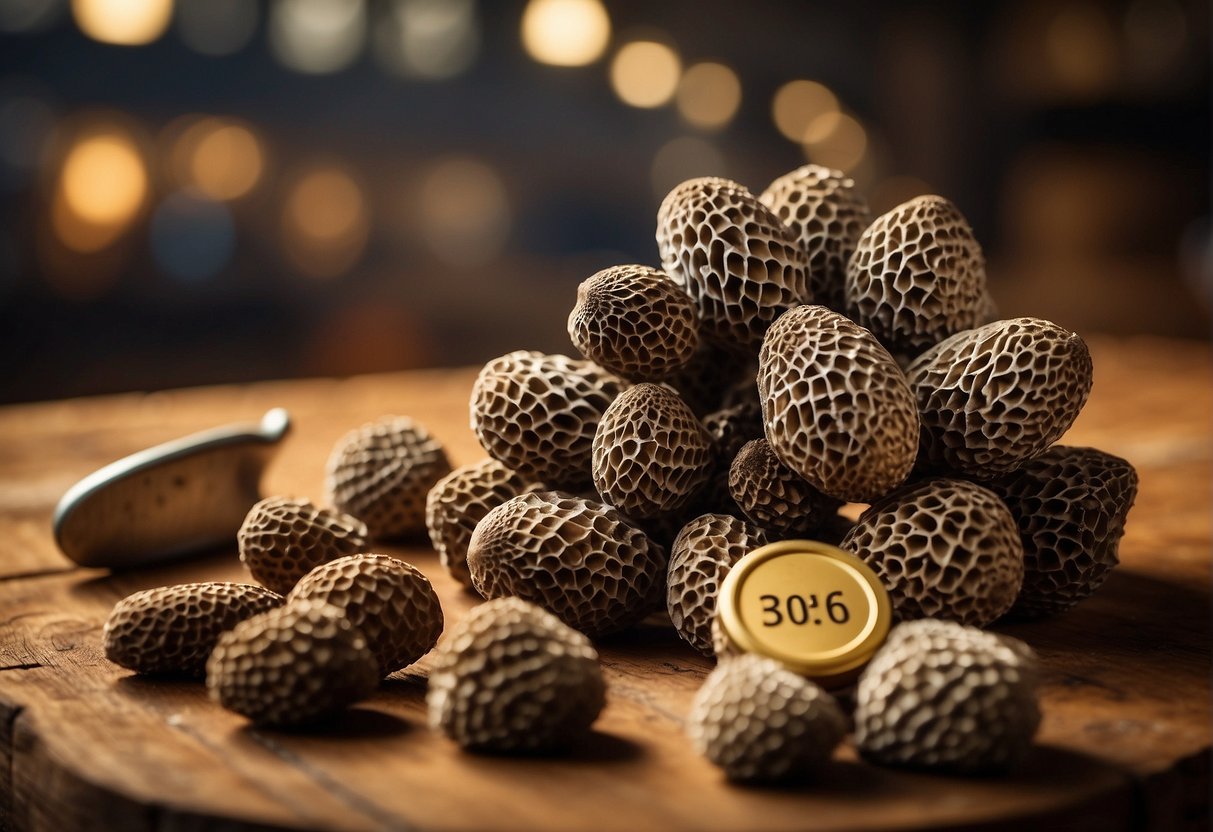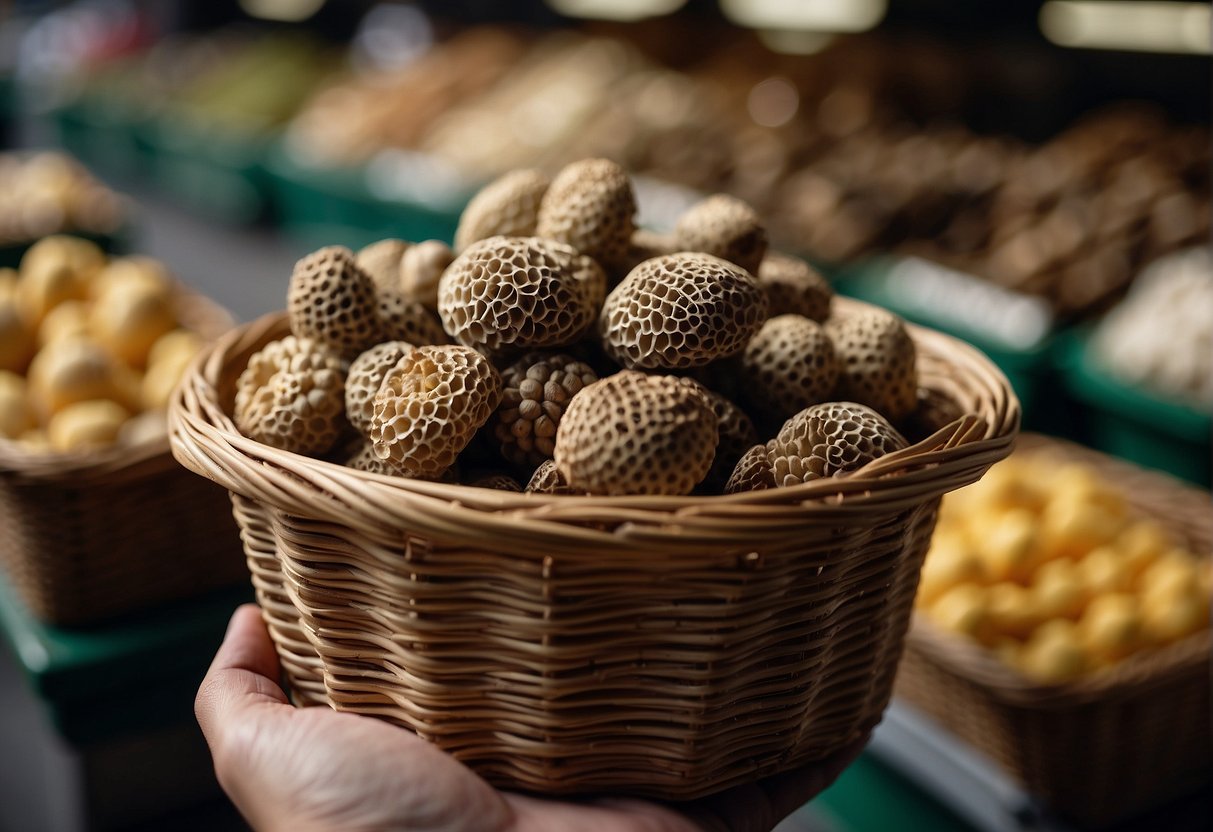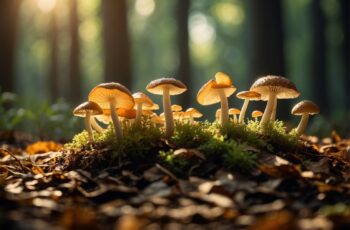Morel mushrooms are a prized find for any outdoors enthusiast. The distinctive honeycomb-like appearance and earthy flavor make these fungi a sought-after delicacy in the culinary world. While they’re often foraged from the wild in the spring, you may find them at local farmers markets or specialty stores, depending on the region and season.

The price of morel mushrooms varies widely, influenced by their availability, size, quality, and where you purchase them. Generally, fresh morels can fetch a price between $37.50 and $53.60 per pound, with some of the finest specimens reaching up to $85 per pound. It’s not uncommon for prices to be lower when the mushrooms are bountiful and higher when they are scarce.
For those with a penchant for the outdoors and a taste for fine food, growing your own morel mushrooms is an option with the help of morel mushroom growing kits. These kits promise to make the creation of a personal morel garden both an achievable and satisfying endeavor. Whether preparing for a gourmet meal or enjoying the thrill of the hunt, knowing the value of morel mushrooms is part of the adventure.
Understanding Morel Mushroom Value
When it comes to the worth of morel mushrooms, several key elements, such as rarity and unique flavor, contribute to their high market value. Here’s what you need to know about what drives the cost of these sought-after fungi.
What Makes Morel Mushrooms Expensive
Morel mushrooms are considered a culinary delicacy, not just because of their earthy, nutty flavor, but also thanks to their limited availability. These mushrooms are not easily cultivated, making wild morels rare and highly desired. Consequently, their rarity and the labor-intensive process of foraging contribute to a higher price.
Factors Influencing Morel Prices
Quality and condition are paramount in determining the value of morel mushrooms. Dried or frozen varieties tend to be less expensive than fresh morels, but the prices can vary drastically based on:
- Supply: The volume of morels available during a given season
- Demand: The desire for morels, driven by chefs and gourmets
- Abundance: A recent, favorable foraging season can temporarily decrease prices
- Volume: Larger quantities purchased may reduce the price per pound
Morel Seasonality and Availability
The price of morels can fluctuate due to seasonality. Morels often appear in the spring, and their availability is subject to the whims of nature, which plays a pivotal role in defining the value. Understanding the morel mushroom prices can help you grab them at the best value, especially since post-season, their supply diminishes, driving prices up until the next harvest.
Foraging and Harvesting Morels
Embarking on the hunt for morels requires a keen eye and knowledge of their elusive nature. Morel mushrooms are a treasured find in the culinary world for their distinctive earthy flavor, and they offer a rewarding experience for food enthusiasts and chefs alike.
Foraging Techniques
Morel foraging can be an exciting springtime adventure. Focus on regions with a known history of morels, especially in forests near ash, elm, and poplar trees. Look for the telltale conical shape of the yellow and black morels amidst the leaf litter. Gentle sweeps of your hand across the forest floor can reveal these camouflaged fungi. Remember, patience and persistence are your allies.
Best Conditions for Morel Growth
The best season for morels is usually spring, when soil temperatures warm to about 45°F – 50°F. Look for mild days when temperatures stay between 60°F and 70°F. Following a rain, morels use the moisture to trigger growth, making post-rain hunts particularly productive. Regions with a recent history of wildfires can also be hotspot as morels thrive in areas where the trees have been burned the previous year.
Harvesting and Cleaning Methods
Once you’ve spotted a morel, cut or pinch the stem at ground level; this method encourages future growth. After the harvest, soak fresh morels in salt water to remove any dirt or critters. Rinse them gently to maintain their textural integrity, as they are hollow and can be delicate. Cleaning is essential before you get to cooking—whether you plan to sauté them for a rich, earthy delight or store them for later use.
Cooking With Morels
Morel mushrooms are prized for their unique, earthy flavor and meaty texture, making them a favorite among foraging enthusiasts and gourmet cooks alike. Proper preparation and the right pairings can make these delicacies shine in your kitchen.
Preparing Morel Mushrooms for Cooking
To ensure the best taste and safety, fresh morel mushrooms should be cleaned thoroughly before cooking. Begin by gently brushing off any debris with a soft brush. If you have dried morels, rehydrate them by soaking in warm water for at least 30 minutes. For fresh morels, a quick soak in salt water can help remove any tiny insects. Afterward, rinse them under cold water and pat them dry with a paper towel. Storage is crucial for maintaining freshness, so place morels in a paper bag and store in the refrigerator if you cannot cook them immediately. For longer preservation, morels can be frozen—either whole or after sautéeing.
Morel Recipes and Pairings
Morels’ unique flavor profile—earthy, nutty, and slightly smoky—lends well to simple sauté recipes that highlight their natural goodness. Begin by heating some oil in a high-quality skillet, add the morels, and gently sauté them until they are golden brown.
For a more decadent experience, incorporate morels into a creamy sauce. They pair excellently with proteins, or you can stir them into risotto for a luxurious touch. The natural nutty flavor of morels also complements the delicate flavors of eggs and pasta dishes. When considering pairings, choose ingredients that won’t overshadow the subtle, earthy notes of the morels.
Remember, morels are not just a treat for your palate; they’re also a great source of protein and fiber. A well-prepared dish of morel mushrooms can take you straight back to the satisfaction of a successful forage, savoring the taste of the great outdoors right at your dining table.
Buying and Storing Morels

When seeking out morels, it’s crucial to know where to find them and how to maintain their freshness. The price per pound, availability, and preservation techniques vary depending on whether you’re dealing with fresh or dried morels. Let’s explore these essential aspects to ensure you make the most of your morel purchases.
Where to Buy Morels
You can purchase fresh morel mushrooms during their season, which typically runs from spring to early summer, depending on your location. Search for morels at farmers’ markets, specialty grocery stores, or online vendors that specialize in gourmet mushrooms. Some outdoor enthusiasts also enjoy foraging for morels, though this requires knowledge of morel habitats, which include areas near elm, ash, and oak trees. Buyers should be aware of the market price fluctuating based on time of year and availability, with fresh morels often commanding a premium. Additionally, dried morel mushrooms can be sourced year-round, providing a convenient option for those who enjoy the rich, earthy flavor of morels regardless of the season.
Storing Fresh and Dried Morels
Fresh Morels:
Upon purchasing or foraging fresh morels, immediate storage is key to extending their shelf life. Freshly foraged morels should be kept in a paper bag and stored in your refrigerator, which can preserve their quality for about a week. To freeze, simply clean them, pat dry, and place them in a freezer-safe container or bag. Frozen morels can last up to six months.
Dried Morels:
For dried morelsーan excellent alternative for year-round useーensure they are stored in an airtight container kept in a cool, dark place. This method can keep dried morels viable for up to a year, allowing you ample time to enjoy these delicacies in your cooking. When ready to use, rehydrate your dried morels by soaking them in warm water, which also produces a flavorful broth that can be used in your recipes.
The approach to buying and storing morels will influence the flavor and quality you bring to your kitchen, so investing time in proper storage methods is paramount for any mushroom enthusiast.


